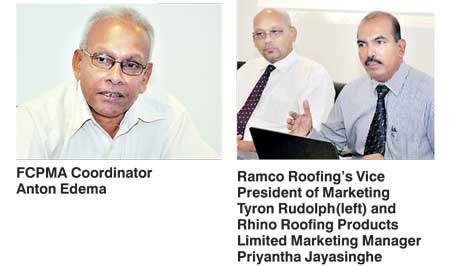Friday Aug 08, 2025
Friday Aug 08, 2025
Friday, 13 November 2015 00:00 - - {{hitsCtrl.values.hits}}
By Madushka Balasuriya
The Fibre Cement Products Manufacturers Association (FCPMA), which represents four of the major asbestos roofing sheet manufacturers in Sri Lanka, has bemoaned the fact that they are yet to hold any form of dialogue with relevant authorities regarding the complete ban on asbestos by 2018, even two months after President Maithripala Sirisena announced the ban.
“So far they haven’t communicated with the industry. We have written to all the relevant authorities but still no response. That’s what has led to this discussion; this is the first of several PR (public relations) initiatives,” revealed  Ramco Roofing’s Vice President of Marketing Tyron Rudolph, speaking at a media roundtable discussion aimed at raising awareness and combating disinformation regarding asbestos.
Ramco Roofing’s Vice President of Marketing Tyron Rudolph, speaking at a media roundtable discussion aimed at raising awareness and combating disinformation regarding asbestos.
FCPMA coordinator Anton Edema went a step further suggesting that something more sinister may be afoot, accusing the Central Environment Authority – which falls under the President in his capacity as Minister of Mahaweli Development and Environment – of holding secret meetings.
“I have contacts [inside the CEA], they used to support us, however they have now been transferred. There are others that we can contact but they don’t divulge any information, they just say that they’ll call us back. In fact they once had a meeting and we were not invited. One person at the meeting had asked why, he had even given my name, but when we called them and asked why they had held a meeting without us, they denied the whole thing. Point blank they said they never had a meeting like that,” charged Edema.
Blue and Brown asbestos was banned in 1997; however chrysotile or white asbestos has been in use since, mainly for the production of fibre cement sheets, more commonly known as roofing sheets, in Sri Lanka.
A statement by the FCPMA called for more research to be conducted with regard to the safe production and use of chrysotile, as well as independent cost/benefit analysis into the use of alternatives.
The statement goes on to note that the composition of fibre cement sheets manufactured locally contain 70% cement, 23% water and only 7% chrysotile (white asbestos) fibres. And even if chrysotile enters the body it is not retained.
“The white asbestos lasts only a short while in the body. However amphibole or blue/brown asbestos is cancerous and lasts longer – for several years,” explained Edema. A 2004 World Health Organisation (WHO) release said asbestos-related lung cancer, mesothelioma and asbestosis from occupational exposures resulted in 107,000 deaths worldwide. That is 107,000 of 125 million people exposed to asbestos at work, or 0.0856%.
Edema said they had requested the WHO to make a clear distinction between the types of asbestos, as industry leaders in the country believe the public is being mislead following the announcement of the ban, which he also believes is due to the misinformation being spread. Currently there are four manufacturers using asbestos in the country, with 4,500 employees collectively. Masconite and Rhino are the market leaders, accounting for roughly 70% of the market share, and the market is worth billions of rupees. A majority of the asbestos is imported from Russia.
– Pix by Lasantha Kumara
Discover Kapruka, the leading online shopping platform in Sri Lanka, where you can conveniently send Gifts and Flowers to your loved ones for any event including Valentine ’s Day. Explore a wide range of popular Shopping Categories on Kapruka, including Toys, Groceries, Electronics, Birthday Cakes, Fruits, Chocolates, Flower Bouquets, Clothing, Watches, Lingerie, Gift Sets and Jewellery. Also if you’re interested in selling with Kapruka, Partner Central by Kapruka is the best solution to start with. Moreover, through Kapruka Global Shop, you can also enjoy the convenience of purchasing products from renowned platforms like Amazon and eBay and have them delivered to Sri Lanka.
Discover Kapruka, the leading online shopping platform in Sri Lanka, where you can conveniently send Gifts and Flowers to your loved ones for any event including Valentine ’s Day. Explore a wide range of popular Shopping Categories on Kapruka, including Toys, Groceries, Electronics, Birthday Cakes, Fruits, Chocolates, Flower Bouquets, Clothing, Watches, Lingerie, Gift Sets and Jewellery. Also if you’re interested in selling with Kapruka, Partner Central by Kapruka is the best solution to start with. Moreover, through Kapruka Global Shop, you can also enjoy the convenience of purchasing products from renowned platforms like Amazon and eBay and have them delivered to Sri Lanka.